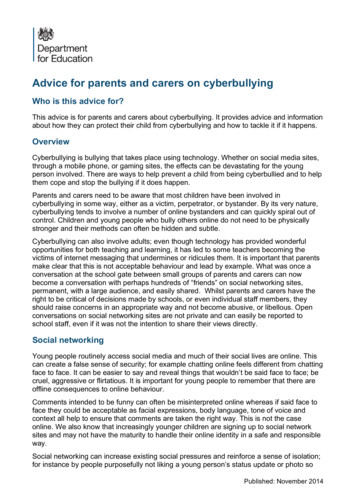
Transcription
CyberbullyingBullying is aggressive behavior that is intentional andinvolves an imbalance of power or strength. Usually,it is repeated over time. Traditionally, bullyinghas involved actions such as: hitting or punching(physical bullying), teasing or name-calling (verbalbullying), or intimidation through gestures or socialexclusion. In recent years, technology has givenchildren and youth a new means of bullyingeach other.Cyberbullying, which is sometimes referred to asonline social cruelty or electronic bullying, has beendefined as “an aggressive, intentional act carriedout by a group or individual, using electronic formsof contact, repeatedly and over time against avictim who cannot easily defend him or herself”(Smith et al., 2008, p. 376).Cyberbullying can involve: Sending mean, vulgar, or threatening messagesor images Posting sensitive, private information and/or liesabout another person Pretending to be someone else in order to makethat person look bad Intentionally excluding someone from an onlinegroup (Willard, 2007)Children and youth can cyberbully each otherthrough: Emails Instant messaging Text or digital imaging messages sent on cellphones Social networking sites Web pages Blogs Chat rooms or discussion groups Other cyber technologiesBullying via instant messaging appears to beparticularly prevalent (Dehue et al., 2008; Kowalskiet al., 2008; Sourander et al., 2010).How common is cyberbullying?Research studies have produced different answersto this question. Rates of cyberbullying varydepending on the definition of cyberbullying thatis used, the ages and characteristics of childrensurveyed, and the time frame involved (Kowalski &Limber, under review). In a Cox Communications (2009) survey 13-18year-olds were asked how often they had everbeen involved in cyberbullying.– 15% said they had been cyberbullied online– 10% had been cyberbullied by cell phone– 7% said they had cyberbullied another persononline– 5% had cyberbullied another person by cellphone A study by Fight Crime: Invest in Kids (2006)investigated how often children (6-11 yearolds) and teens (12-17-year-olds) had beencyberbullied during the previous year. One-thirdof teens and one-sixth of the children reportedthat someone said threatening or embarrassingthings about them online. In a survey of middle school students, Hindujaand Patchin (2009) found that 9% had beencyberbullied in the last 30 days, and 17% hadbeen cyberbullied during their lifetime; 8% hadcyberbullied others in the last 30 days and18% had done so during their lifetime.
In a study by Kowalski and Limber (2007) withstudents in grades 6-8, 18% said they had beencyberbullied at least once in the last couple of monthsand 6% said it had happened two or more times;11% had cyberbullied others at least once in the lastcouple of months, and 2% said they had done it twoor more times. 45% of preteens and 30% of teens who had beencyberbullied received the messages while at school. 44% of preteens and 70% of teens who had beencyberbullied received the messages at home. 34% of preteens and 25% of teens who had beencyberbullied received the messages while at a friend’shouse.Who is involved in cyberbullying?Children’s reactions to cyberbullyingAlthough some studies have found that girls aremore involved in cyberbullying than boys (CoxCommunications, 2009; Kowalski & Limber, 2007;Pew Internet & American Family Life Project, 2007),others have found similar rates among boys and girls(Hinduja & Patchin, 2008).Most teens (60% of boys and 70% of girls) see onlinebullying as a serious problem and feel that there shouldbe stricter rules about it (70% of boys and 80% of girls)(Cox Communications, 2009).When middle school students were asked about theidentity of the person who cyberbullied them: 52% identified another student at school 36% said they had been cyberbullied by a friend 13% had been cyberbullied by a sister or brother 48% did not know who had cyberbullied them(Kowalski et al., 2008)Children and youth who are involved in cyberbullying arealso quite likely to be involved in “traditional” forms ofbullying. In a study of middle school students (Kowalskiet al., 2008), 61% of cyber “victims” also reported beingvictims of “traditional” bullying; 55% of cyber “bullies”also said they had bullied others in “traditional ways.”Cyber “bully/victims” (who cyberbully others and alsoare cyberbullied) were heavily involved in “traditional”forms of bullying—64% had been bullied and 66% hadbullied others.Where are children cyberbullied?Most cyberbullying is done away from school (Dehue etal., 2008; Smith et al., 2008), although more cyberbullyingmay occur during school than many adults realize. Forexample, in a telephone survey of preteens (6-11-yearolds) and teens (12-17-year-olds) (Fight Crime: Invest inKids, 2006):Many children and teens who are cyberbullied fail toreport it to parents or adults at school (Agatston et al.,2007; Dehue et al., 2008; Smith et al., 2008). According toa telephone survey of preteens and teens (Fight Crime:Invest in Kids, 2006): 51% of preteens but only 35% of teens who hadbeen cyberbullied had told their parents about theirexperience. 27% of preteens and only 9% of teens who had beencyberbullied had told a teacher. 44% of preteens and 72% of teens who had beencyberbullied had told a friend. 31% of preteens and 35% of teens who had beencyberbullied had told a sibling. 16% or preteens and teens who had been cyberbulliedhad told no one.How does cyberbullying affect children?Little research has explored the possible effects ofcyberbullying on children. When students are asked howthey believe cyberbullying affected them, they indicatethat it made them sad and unwilling to attend school(Raskauskas & Stoltz, 2007).A survey of Finish teens aged 13-16 found that victimsof cyber bullying were at a higher risk of havingpsychosomatic problems, such as frequent headachesand problems falling asleep (Sourander et al., 2010).These and other materials are available online at: www.StopBullying.gov
A survey of middle and high school students in the U.S.found that children who were cyber “bully/victims” (hadcyberbullied others and also had been cyberbullied)had the highest rates of anxiety, depression and schoolabsences compared to cyber “bullies”, cyber “victims”and children who weren’t involved in cyberbullying. Bycontrast, children not at all involved in cyberbullyinghad the highest self-esteem and grades and the fewestsymptoms of health problems (Kowalski & Limber, underreview).How does cyberbullying differ from othertraditional forms of bullying?Research and experience suggest that cyberbullyingmay differ from more “traditional” forms of bullying ina number of ways (Kowalski et al., 2008; Slonje & Smith,2008, 2005), including: Cyberbullying can occur any time of the day or night. Cyberbullying messages and images can be distributedquickly to a very wide audience. Children and youth can be anonymous whencyberbullying, which makes it difficult (and sometimesimpossible) to trace.What can adults do to preventand address cyberbullying?Adults may not always be present in the onlineenvironments of children and youth. Therefore, it isextremely important that adults pay close attention tocyberbullying and the activities of children and youthwhen using these newer technologies. Suggestions for Parents: Tips to Prevent Cyberbullying Suggestions for Parents: Tips for Dealing withCyberbullying Suggestions for EducatorsSuggestions for parents:tips to help prevent cyberbullying: Make an agreement with your children to keep allinternet capable devices out of children’s bedrooms. Talk regularly with your child about online activitiesthat he or she is involved in. Talk specifically aboutcyberbullying and encourage your child to tell youimmediately if he or she is the victim of cyberbullying,cyberstalking, or other illegal or troublesome onlinebehavior. Explain that you will not take away theirtechnology if they confide in you about a problem theyare having. View the SBN! Campaign’s Webisodes with your childand discuss in particular Webisode 5 that addressescyberbullying. Encourage your child to tell you if he or she is aware ofothers who may be the victims of cyberbullying. Explain that cyberbullying is harmful and unacceptablebehavior. Outline your expectations for responsibleonline behavior and make it clear that there will beconsequences for inappropriate behavior. Explain thattreating others well online may also protect them frombeing harassed or cyberbullied. Although adults must respect the privacy of childrenand youth, concerns for your child’s safety maysometimes override these privacy concerns. Tell yourchild that as a responsible parent you may review his orher online communications if you think there is reasonfor concern. Consider installing parental control filtering softwareand/or monitoring programs, but do not rely solely onthese tools.Suggestions for parents:tips for dealing with cyberbullying:Because cyberbullying can range from rude commentsto lies, impersonations, and threats, your responses maydepend on the nature and severity of the cyberbullying.Here are some actions that you may want to take afterthe-fact.These and other materials are available online at: www.StopBullying.gov
Strongly encourage your child not to respond to thecyberbullying. Do not erase the messages or pictures. Save themas evidence. Try to identify the individual doing the cyberbullying.Even if the cyberbully is anonymous (e.g., is using a fakename or someone else’s identity) there may be a wayto track them through your Internet Service Provider.If the cyberbullying is criminal (or if you suspect thatit may be), contact the police and ask them to dothe tracking. Jurisdictions and states differ in theirdefinitions of what constitutes criminal behavior, butthe following may constitute a crime (Willard, 2007):– Threats of violence– Extortion– Obscene or harassing phone calls or text messages– Harassment, stalking, or hate crimes– Child pornography– Sexual exploitation– Taking a photo image of someone in a place wherehe or she would expect privacy Sending inappropriate language may violate the“Terms and Conditions” of email services, InternetService Providers, Web sites, and cell phone companies.Consider contacting these providers and filing acomplaint. If the cyberbullying is coming through email or a cellphone, it may be possible to block future contact fromthe cyberbully. Of course, the cyberbully may assume adifferent identity and continue the cyberbullying. Contact your school. If the cyberbullying is occurringthrough your school district’s Internet system, schooladministrators have an obligation to intervene. Evenif the cyberbullying is occurring off campus, make theschool administrators aware of the problem. They maybe able to help you resolve the cyberbullying or bewatchful for face-to-face bullying. Consider contacting the cyberbully’s parents. Theseparents may be very concerned to learn that theirchild has been cyberbullying others, and they mayeffectively put a stop to the bullying. On the otherhand, these parents may react negatively to yourcontacting them. So, proceed cautiously. If you decideto contact a cyberbully’s parents, communicate withthem in writing—not face-to-face. Present proof of thecyberbullying (e.g., copies of an email message) and askthem to make sure the cyberbullying stops. Consider contacting an attorney in cases of seriouscyberbullying. In some circumstances, civil law permitsvictims to sue a bully or his or her parents in order torecover damages. Contact the police if cyberbullying involves acts such as:– Threats of violence– Extortion– Obscene or harassing phone calls or text messages– Harassment, stalking, or hate crimes– Child pornography– Sexual exploitation– Taking a photo image of someone in a place wherehe or she would expect privacyIf you are uncertain if cyberbullying violates yourjurisdiction’s criminal laws, contact your local police, whowill advise you.Suggestions for educators Educate your students, teachers, and other staffmembers about cyberbullying, its dangers, and what todo if someone is cyberbullied. Be sure that your school’s anti-bullying rules andpolicies address cyberbullying.These and other materials are available online at: www.StopBullying.gov
Closely monitor students’ use of computers at school. Use filtering and tracking software on all computers,but don’t rely solely on this software to screen outcyberbullying and other problematic online behavior. Investigate reports of cyberbullying immediately. Ifcyberbullying occurs through the school district’sInternet system, you are obligated to take action. If thecyberbullying occurs off-campus, consider what actionsyou might take to help address the bullying:– Notify parents of victims and parents ofcyberbullies of known or suspected cyberbullying.– Notify the police if the known or suspectedcyberbullying involves a threat.– Closely monitor the behavior of the affectedstudents at school for possible bullying.– Talk with all students about the harms caused bycyberbullying. Remember—cyberbullying thatoccurs off-campus can travel like wildfire amongyour students and can affect how they behave andrelate to each other at school.– Investigate to see if the victim(s) of cyberbullyingcould use some support from a school counselor orschool-based mental health professional. Contact the police immediately if known or suspectedcyberbullying involves acts such as:– Threats of violence– Extortion– Obscene or harassing phone calls or text messages– Harassment, stalking, or hate crimes– Child pornography– Sexual exploitation– Taking a photo image of someone in a place wherehe or she would expect privacyReferences and ResourcesAgatston, P. W., Kowalski, R. & Limber, S. (2007). Students’ perspectives on cyber bullying. Journal of Adolescent Health, 41, S59-S60.Cox Communications (2009). Teen online & wireless safety survey: Cyberbullying, sexting, and parental controls. www.cox.com/takecharge/safe teens 2009/media/2009 teen survey internet and wireless safety.pdfDeHue, F., Bolman, C., & Vollink, T. (2008). Cyberbullying: Youngsters’ experiences and parental perception. Cyber Psychology & Behavior, 11, 217-223.Fight Crime: Invest in Kids (2006). Cyber bully pre-teen. een.pdfFight Crime: Invest in Kids (2006). Cyber bully teen. .pdfHinduja, S. & Patchin, J. W. (2008). Cyberbullying: An exploratory analysis of factors related to offending and victimization. Deviant Behavior, 29, 129-136.Kowalski, R., M., & Limber, S. P. (under review). Psychological, physical, and academic correlates of cyber bullying and traditional bullying.Kowalski, R. N., & Limber, S. P. (2007). Electronic bullying among middle school students. Journal of Adolescent Health, 41, S22-S30.Kowalski, R. M., Limber, S. P., & Agatston, P. W. (2008). Cyber bullying: Bullying in the digital age. Malden, MA: Blackwell.Pew Internet & American Life Project (2007). www.pewinternet.org/ mo.pdf.pdfRaskauskas, J., & Stoltz, A. D. (2007). Involvement in traditional and electronic bullying among adolescents. Developmental Psychology, 43, 564-575.Slonje, R. & Smith, P. K. (2008). Cyberbullying: Another main type of bullying? Scandanavian Journal of Psychology, 49, 147-154.Sourander, A., Brunstein Klomek, A., Ikonen, M., Lindroos, J., Luntamo, T., Koskelainen, M., Ristkari, T., & Helenius, H. (2010). Psychosocial risk factorsassociated with cyberbullying among adolescents. Archives of General Psychiatry, 67, 720-728.Smith, P. K., Mahdavi, J., Carvalho, M., Fisher, S., Russell, S., & Tippett, N. (2008). Cyberbullying: Its nature and impact in secondary school pupils. Journal ofChild Psychology and Psychiatry, 49, 376-385.Willard, N. (200). Cyber bullying and cyberthreats: Responding to the challenge of online social cruelty, threats, and distress. Champaign, IL, Research Press.These and other materials are available online at: www.StopBullying.gov
(Cox Communications, 2009). Many children and teens who are cyberbullied fail to report it to parents or adults at school (Agatston et al., 2007; Dehue et al., 2008; Smith et al., 2008). According to a telephone survey of preteens and teens (Fight Crime: Invest in Kids, 2006): 51% of preteens but only 35% of teens who had










